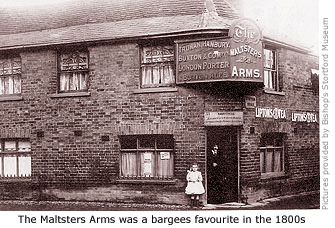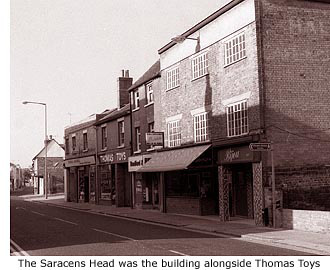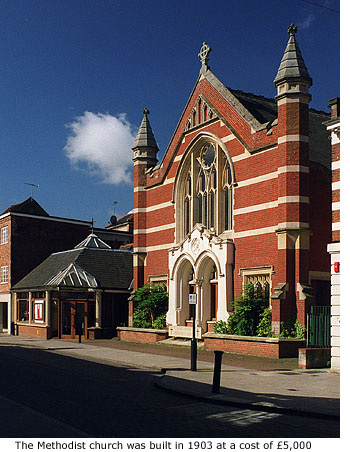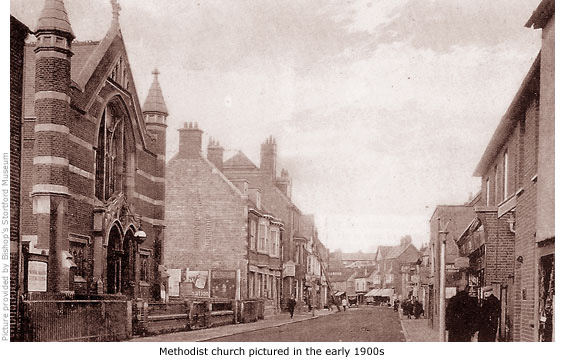|
 Once standing on the north-east corner of Station Road and South Street was the Maltsters Arms, always a firm favourite of bargees in the 19th century because unrestricted licensing laws meant it could open for business early in the day. The landlord no doubt became a rich man, but by 1920 the river no longer supported barge transport and the pub closed. It was replaced in 1926 by the unusual terrace of shops that now stand here, named Stort Corner (See Guide 11). Once standing on the north-east corner of Station Road and South Street was the Maltsters Arms, always a firm favourite of bargees in the 19th century because unrestricted licensing laws meant it could open for business early in the day. The landlord no doubt became a rich man, but by 1920 the river no longer supported barge transport and the pub closed. It was replaced in 1926 by the unusual terrace of shops that now stand here, named Stort Corner (See Guide 11).
|
|
 In the 19th century No 70 was the Saracen’s Head public house, more popularly known as Perry’s lodging house or ‘the old pan and can’. It was named as such because permanent inmates were expected to provide their own pan and can for frying food and brewing tea. In the 19th century No 70 was the Saracen’s Head public house, more popularly known as Perry’s lodging house or ‘the old pan and can’. It was named as such because permanent inmates were expected to provide their own pan and can for frying food and brewing tea.
Despite its guise as a lodging house it was actually little more than a brothel, the entrance alongside the building leading to its stable yard and a small row of cottages with a communal room. The Saracen’s Head closed in 1970, though there's no evidence to suggest it remained a brothel until that time.
|
|
 The first Methodist service held in Bishop’s Stortford took place in 1823 beneath a large tree in the Causeway, the congregation led by a Mr Anthony, who later became Master of Hockerill Union Workhouse. The following year a seed warehouse in Church Street was purchased and converted into a chapel, and the first minister appointed in 1828. The first Methodist service held in Bishop’s Stortford took place in 1823 beneath a large tree in the Causeway, the congregation led by a Mr Anthony, who later became Master of Hockerill Union Workhouse. The following year a seed warehouse in Church Street was purchased and converted into a chapel, and the first minister appointed in 1828.
As the number of Wesleyans in Stortford increased, a plot of land was purchased in South Street (opposite Apton Road) and a much larger chapel erected on the site in 1866. Meetings continued here until 1903, at which time the congregation moved to this new Methodist church erected on the site of a former malting. Costing the princely sum of £5,000 and taking less than a year to build, it was described at the time as a ‘handsome and commodious chapel’. But by the 1980s the ‘commodious’ chapel was becoming a little cramped, so a new entrance extension was added and the interior and frontage renovated.
|
|
The founder of Methodism was the English evangelical preacher John Wesley (1703–1791), a rector’s son who was educated at Oxford and ordained as a priest in the Church of England in 1728. He later taught Greek at Oxford and became a member of a small group of students who were derisively called Methodists for their methodical devotion to study and religious duties.
In 1735 Wesley joined English settlers as a missionary in Georgia, America, then returned three years later to settle in Bristol. But his passionate sermons there soon upset local clergy, and when pulpits were closed to him he built his own Methodist Chapel in the city in 1739. He also regularly travelled the country visiting poor neighbourhoods in industrial and agricultural areas, preaching on personal morality and warning against the dangers of gambling and drinking.
Wesley eventually visited Bishop’s Stortford in March 1775, and though he didn't come here to preach he described the town as a spiritual desert. His impression of the town was further sullied when a snowstorm forced him to stay in the Red Lion Inn at Hockerill. It was, he said, the dearest house he had ever been. Wesley probably passed through Bishop’s Stortford on other occasions when journeying to Norwich, though he normally travelled there via Colchester and Ipswich visiting Methodist groups along the way.
In 1784 Wesley established the legal status of Methodist societies, and though he didn't form a separate church he made plans for the societies to continue after his death. When that event finally occurred in 1791, it was calculated he had delivered some 40,000 sermons and given away £30,000. He remains one of the few Britons, apart from Henry VIII and George Fox of the Quakers, who can claim to have founded a religious denomination. At the time of his death the British Methodist movement had around 76,000 members. Today the number is in excess of 300,000, while worldwide membership is 38 million and growing. MORE PICTURES

|

